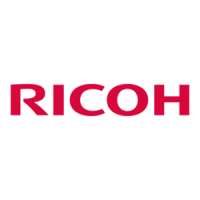2.Image Quality Problems
656
charge from the transfer electrical field, thus reducing the efficiency of image transfer. This may also
occur when:
Ambient temperature and humidity are low
Paper is extremely thick
Electrical resistance of paper is high
Duplex printing (problem occurs on Side 2).
To adjust the following settings, register beforehand the type of paper that you are using as a
custom paper.
Solution:
Check duplex prints and determine on which side the problem occurs. If the problem occurred on both
sides, make adjustments for Side 1 first, and then for Side 2.
1. In Advanced Settings for the custom paper in use, check the settings for Paper Transfer Current
Setting: Side 1 (SP2-641-100 to 178: PTR Current:Side1 Custom Paper 100 to 178), or Paper
Transfer Current Setting: Side 2 (2-642-100 to 178: PTR Current:Side2 Custom Paper 100 to 178).
2. Is either or both settings at the upper limit?
3. Are the white spots of a degree acceptable for the client?
4. Raise the transfer current setting by 5 points.
5. Print the image. Is the problem resolved?
6. Can you change the orientation of the paper (SEF to LEF, for example), or change the paper size
(A4 SEF to A3 SEF)?
7. Use wider paper.
8. Restore the image transfer voltage to its default setting, and then go back to Step 4.
9. If the problem is not resolved, consult the product specialist.
Raising the image transfer voltage can cause white spots to occur in filled areas, so keep this
in mind when doing the adjustments. If white spots appear, make some output samples; select
the best from among the test prints, and use those settings.

